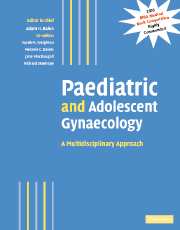Book contents
- Frontmatter
- Contents
- Contributors
- Preface
- Part I Normal development
- Part II Management of developmental abnormalities of the genital tract
- Part III Management of specific disorders
- 18 Disorders of growth and puberty
- 19 Turner's syndrome
- 20 Androgen insensitivity syndromes
- 21 Rokitansky syndrome and other Müllerian anomalies
- 22 The XY female
- 23 The gynaecology of the major genitourinary anomalies
- 24 Congenital adrenal hyperplasia
- 25 Long-term sequelae of genital surgery
- 26 Amenorrhoea
- 27 The polycystic ovary syndrome and adolescent women
- 28 Menstrual disorders in adolescent girls
- 29 Pelvic pain, ovarian cysts and endometriosis in adolescent girls
- 30 Premature ovarian failure and ovarian ageing
- 31 Gynaecological cancers in childhood
- 32 Late reproductive sequelae of treatment for childhood cancer
- 33 Preservation of fertility before cancer therapy
- 34 The management of infertility with surrogacy and egg donation
- 35 Dermatological conditions of the female genitalia
- 36 Vaginal discharge
- 37 Psychological gender development in individuals born with ambiguous genitalia
- 38 Eating disorders in adolescence
- 39 Nutritional amenorrhoea: long-term sequelae
- 40 How to set up a service: how to teach and train
- Index
- Plate section
- References
22 - The XY female
from Part III - Management of specific disorders
Published online by Cambridge University Press: 04 May 2010
- Frontmatter
- Contents
- Contributors
- Preface
- Part I Normal development
- Part II Management of developmental abnormalities of the genital tract
- Part III Management of specific disorders
- 18 Disorders of growth and puberty
- 19 Turner's syndrome
- 20 Androgen insensitivity syndromes
- 21 Rokitansky syndrome and other Müllerian anomalies
- 22 The XY female
- 23 The gynaecology of the major genitourinary anomalies
- 24 Congenital adrenal hyperplasia
- 25 Long-term sequelae of genital surgery
- 26 Amenorrhoea
- 27 The polycystic ovary syndrome and adolescent women
- 28 Menstrual disorders in adolescent girls
- 29 Pelvic pain, ovarian cysts and endometriosis in adolescent girls
- 30 Premature ovarian failure and ovarian ageing
- 31 Gynaecological cancers in childhood
- 32 Late reproductive sequelae of treatment for childhood cancer
- 33 Preservation of fertility before cancer therapy
- 34 The management of infertility with surrogacy and egg donation
- 35 Dermatological conditions of the female genitalia
- 36 Vaginal discharge
- 37 Psychological gender development in individuals born with ambiguous genitalia
- 38 Eating disorders in adolescence
- 39 Nutritional amenorrhoea: long-term sequelae
- 40 How to set up a service: how to teach and train
- Index
- Plate section
- References
Summary
Introduction
In most pregnancies, fetal sexual development progresses smoothly down one of two paths leading to a male infant with an XY karyotype, scrotal testes and standard male genitalia or a female infant with an XX karyotype, ovaries and a uterus, and standard female external genitalia. However human fetal sexual determination and differentiation is complex and can be diverted from these dual standard pathways at a multitude of different points. When such a diversion occurs, the developing fetus can either switch over to the other pathway or blend the two, resulting in the birth of an intersex child.
Named androgynes by the Greeks, and later hermaphrodites by the Romans, no clear definition exists for the term “intersex”, and correspondingly incidence figures vary greatly according to the conditions included (Blackless et al., 2000; Duckett et al., 1993; Quigley et al., 1995). In this chapter, the term intersex is used to mean a person with a mix or blend of the physically defining features (i.e. karyotype, gonadal structure, internal genitalia and external genitalia) usually associated with standard males and females. The term intersex, therefore, covers a diverse range of conditions encompassing individuals with standard male or female genitalia, who may have a variety of internal genital organs and karyotypes, and also those with ambiguous external genitalia. There are currently over 15 recognized intersex conditions, and in many of these there is an XY karyotype or some cells that are XY (Table 22.1).
- Type
- Chapter
- Information
- Paediatric and Adolescent GynaecologyA Multidisciplinary Approach, pp. 275 - 292Publisher: Cambridge University PressPrint publication year: 2004
References
- 1
- Cited by

